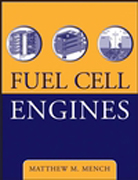
Fuel Cell Engines is an introduction to the fundamental principles of electrochemistry, thermodynamics, kinetics, material science and transport applied specifically to fuel cells. It covers scientific fundamentals and provides a basic understanding that enables proper technical decision-making. The fundamentals are applicable to all fuel cell systems, but special focus is given to polymer electrolyte membrane fuel cells. INDICE: Chapter 1. Introduction to Fuel Cells. 1.1 Preliminary Remarks. 1.2 Fuel Cells as Electrochemical Engines. 1.3 The Generic Fuel Cell and Stack. 1.4 Classification of Fuel Cells. 1.5 Potential Fuel Cell Applications and Markets. 1.6 History of Fuel Cell Development. 1.7 Summary. Chapter 2. Basic Electrochemical Principles. 2.1 Electrochemical versus Chemical Reactions. 2.2 TheElectrochemical Reaction. 2.3 Scientific Units, Constants, and Basic Laws. 2.4 Faraday?s Laws ? Consumption and Production of Specie. 2.5 Measures of Reactant Utilization Efficiency. 2.6 The Generic Fuel Cell. 2.7 Summary. Chapter 3.Thermodynamics of Fuel Cell Systems. 3.1 The Physical Nature of the Thermodynamic Variables. 3.2 Heat of Formation, Sensible Enthalpy, and Latent Heat. 3.3Determination of the Change in Enthalpy for Non-reacting Species and Mixtures. 3.4 Determination of the Change in Enthalpy for Reacting Species and Mixtures. 3.5 Psychrometrics- Thermodynamics of Moist Air Mixtures. 3.6 ThermodynamicEfficiency of a Fuel Cell. 3.7 Maximum Expected Open Circuit Voltage-The Nernst Voltage. 3.8 Summary. Chapter 4. Performance Characterization of Fuel Cell Systems. 4.1 Polarization Curve. 4.2 Region I: Activation Polarization. 4.3 Region II: Ohmic Polarization. 4.4 Region III: Concentration Polarization. 4.5 Region IV: Other Polarization Losses. 4.6 Polarization Curve Model 4.7 Summary.Chapter 5. Transport in Fuel Cell Systems. 5.1 Ion Transport in the Electrolyte. 5.2 Electron Transport. 5.3 Gas-Phase Mass Transport. 5.4 Single-Phase Flow in Channels. 5.5 Multi-Phase Mass Transport in Channels and Porous Media. 5.6 Heat Generation and Transport. 5.7 Summary. Chapter 6. The Polymer Electrolyte Fuel Cell 6.1 The Hydrogen PEFC. 6.2 Water Balance in a H2 PEFC. 6.3 Flow Field Configurations and Stack Design. 6.4 Direct Alcohol Polymer Electrolyte Fuel Cells. 6.5 PEFC Degradation. 6.6 Multi-dimensional Effects. 6.7 Summary. Chapter 7. Other Fuel Cells. 7.1 Solid Oxide Fuel Cells. 7.2 Molten Carbonate Fuel Cells. 7.3 Phosphoric Acid Fuel Cells. 7.4 Alkaline Fuel Cells. 7.5 Biological and Microbial Fuel Cells. 7.6 Summary. Chapter 8. Hydrogen Storage, Generation, and Delivery. 8.1 Modes of Storage. 8.2 Modes of Generation. 8.3 Hydrogen Delivery 8.4 Summary. Chapter 9. Experimental Diagnostics and Diagnosis. 9.1 Methods to Delineate Polarization Curve Losses. 9.2 Physical Probes and Visualization. 9.3 Degradation Measurements. 9.4 Summary. Appendix. Tables, Figures, and Charts. Index to Tables, Figures, and Charts. Index to Textbook.
- ISBN: 978-0-471-68958-4
- Editorial: John Wiley & Sons
- Encuadernacion: Cartoné
- Páginas: 528
- Fecha Publicación: 13/02/2008
- Nº Volúmenes: 1
- Idioma: Inglés
